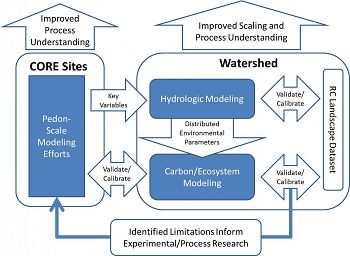Numerical Models
The RC CZO modeling approach will employ pedon-scale models to improve process understanding, hydrologic modeling to create high resolution distributed environmental parameters and carbon/ecosystem modeling to predict soil carbon distribution and identify weaknesses in conceptual knowledge and scaling efforts.
Integration of RC CZO datasets and models
|
|
Datasets |
Pedon-scale modeling |
Landscape-scale modeling |
|
Pools |
SOC, SIC, nutrients, physical fractionation, other physio-chemical soil properties, mineral phases present |
Provides both initial conditions and modeling targets for geochemical modeling |
Constrain soil hydraulic and thermal properties, partition soil C between appropriate belowground model pools |
|
Aboveground ground C stocks, foliar N |
Not directly used, may provide system-level constraints |
Assess partitioning of assimilated C to leaf and stem C, test assumption of N-limitation on vegetation GPP |
|
|
Fluxes |
Aboveground and belowground NPP |
BNPP will constrain carbon production rates. |
Assess simulated NPP in vegetation dynamics models |
|
Litterfall |
Input term at upper boundary of model domain |
Constrain canopy C loss and input to soil C pools |
|
|
Eddy flux NEE |
Not directly used, may provide system-level constraints |
Evaluate modeled ET and constrain NPP |
|
|
Sapflux |
Not directly used, may provide system-level constraints |
Assess model partitioning of ET as transpiration |
|
|
Litter decomposition |
May impact upper boundary carbon input term |
Constrain net rate of input of C to soil, partitioning of litter loss to decomposition and soil input |
|
|
Soil respiration |
Modeling target for CO2 generation/consumption |
Evaluate simulated soil respiration rates |
|
|
Soil lysimeter |
Porewater chemistry will provide both initial conditions and modeling targets for geochemical modeling |
Assess model partitioning of ET as soil evaporation |
Explore Further

